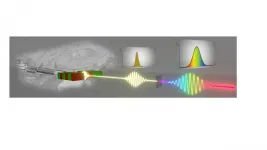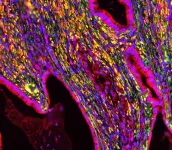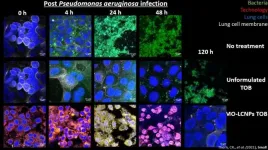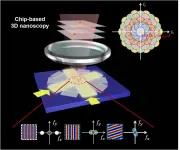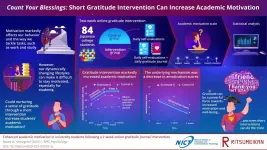(Press-News.org) Arizona! The sunsets. The saguaros. The snakes.
All of them are part of life in the sunny Southwest, but keeping cool when the latter is holed up in a golf bag, air compressor or swimming pool pump house is a big ask for a lot of people.
Not as big as you'd think, however.
The first study to analyze snake removals in a social-ecological context was recently published by an Arizona State University conservation biologist working with a local rattlesnake removal company.
"I think one of the surprises was that people don't hate snakes," said researcher Heather Bateman of the College of Integrative Sciences and Arts. "A lot of them responded that the snakes are important to the desert ecosystem and the snake belongs in the desert, just not in my garage."
Snakes were most frequently removed from neighborhoods with wealthier and more highly educated residents, a greater proportion of Hispanic residents and recently constructed homes.
Bateman studied the records from 2,000 snake removals in metro Phoenix between 2018 and 2019. More than 68% of removals were venomous Western diamondback rattlesnake, the most common species in the area.
The contact zone for rattlesnakes and other species tends to be on the Valley fringes, said Bryan Hughes, owner of Rattlesnake Solutions. He gets the most calls from north of the Loop 101 freeway in Phoenix, Scottsdale and Cave Creek.
"A lot of that (area) has this very deep penetration zone where you can find rattlesnakes miles into areas that have been developed," Hughes said. "And that's just because of the way that the properties are developed. They leave natural waterways in place. They tend to use xeric landscaping on larger lots."
They also turn up in Phoenix around the mountain preserves. "That contact zone is razor thin," he said. "It's basically just that first row of houses that surround those parks."
Snake removal was high in neighborhoods with high income, the study found. But in high-income and high-education areas, snake removal was lower.
"That might indicate that there is an understanding that snakes play these important roles in ecosystems and maybe they're OK to be left in place or handled a different way," Bateman said. "Maybe it's because ... they understand the positive benefits of snakes and are less concerned and maybe decide against removal."
Snakes rarely get inside houses. If they do, they came in through an open door, Hughes said.
"We do have a lot of people that move here from cooler environments where a nice spring day means you leave the back patio unlocked and open a little bit and rattlesnakes will come in there occasionally that way, but very rarely," he said. "Most of the time when we get snakes at people's houses, it's in the backyard or the front yard where a lot of the landscaping, as the paper shows, is something that can be useful or mimics in some ways native landscaping that they use."
Hughes grew up in Idaho catching snakes for fun. He moved to Arizona 22 years ago.
"My interest in snakes changed from garter snakes to rattlesnakes at that point," he said.
He has been in business for about 10 years. He has about 25 employees positioned around the Valley and Tucson, who can usually show up for a call in half an hour.
"We have a massive data set just because we're out there and able to collect a lot of information," he said. "So I'm really excited about this type of collaboration."
The amount of data Hughes had on hand was a delight to Bateman.
"There's a lot that ecologists can gain and by partnering with the business community," she said. "What a great relationship to pair scientists with this business who also is using science. They understand their snakes. And they're contributing to what we know just about the natural history of these species. ... If I look at other sources of information of snakes in Maricopa County, I can go to the scientific literature and there's a couple of papers. And they studied snakes for years. They used road writing surveys (where biologists walk or drive down roads and record what they find) and other types of surveys. And they found on the order of hundreds of snakes, not thousands of snakes."
The published study will be of use to Hughes in his work as well.
"One of the biggest things that I saw that is going to have a lot of use for me just dealing with the public is the fact that how people felt about snakes was not meaningfully impacted by whether or not it's an area that a lot of snakes are removed," he said. "I've always thought that our culture has a lot to do with whether or not people feel positively or negatively about snakes. And a lot of what's in there suggests that, which gives me a lot of lessons about how, when I'm talking to somebody that is scared of snakes, how I can talk with them and how I might be able to change their mind."
INFORMATION:
480-727-4502 scott.seckel@asu.edu
Optical imaging systems have been playing an essential role in scientific discovery and societal progress for several centuries. For more than 150 years scientists and engineers have used aberration theory to describe and quantify the deviation of light rays from ideal focusing in an imaging system. Until recently most of these imaging systems included spherical and aspherical refractive lenses or reflective mirrors or a combination of both. With the introduction of new ultra-precision manufacturing methods, it has become possible to fabricate lenses and mirrors that lack the common translational or ...
The relevance for radiology applications is probably the most known advantage of X-ray beams (keV energies) with respect to visible radiation (eV energies) and can be traced back to their superior penetration depth. On a more fundamental ground, however, the relevance of this photon energy range relies on the capability of probing inner shell electrons (as they have comparable binding energies) and mapping molecular structures on the atomic-scale (as typical interatomic spacings are comparable to X-ray wavelengths). Building on such capabilities, large efforts have been devoted by the scientific community to develop X-ray sub-picosecond sources able to access matter properties with a time resolution sufficient to access elemental molecular motions. Free electron lasers (FEL), nowadays available ...
UNSW medical researchers have found a way to starve pancreatic cancer cells and 'disable' the cells that block treatment from working effectively. Their findings in mice and human lab models - which have been 10 years in the making and are about to be put to the test in a human clinical trial - are published today in Cancer Research, a journal of the American Association for Cancer Research.
"Pancreatic cancer has seen minimal improvement in survival for the last four decades - and without immediate action, it is predicted to be the world's second biggest ...
The Indian public blamed foreigners, minority groups and doctors for the rapid spread of COVID-19 across the country during the first wave, due to misinformation, rumour and long-held discriminatory beliefs, according to an international study led by Monash University.
This resulted in people refusing to get tested for fear of humiliation or public reprisals, which included attacks on Muslims and health care workers.
However, when presented with accurate and reliable information about the virus spread, the Indian public back-pedalled on those negative sentiments and were more likely to get tested and seek medical help, highlighting the importance of health advice from credible sources.
A ...
World-first nanotechnology developed by the University of South Australia could change the lives of thousands of people living with cystic fibrosis (CF) as groundbreaking research shows it can improve the effectiveness of the CF antibiotic Tobramycin, increasing its efficacy by up to 100,000-fold.
The new technology uses a biomimetic nanostructured material to augment Tobramycin - the antibiotic prescribed to treat chronic Pseudomonas aeruginosa lung infections in severe cases of CF - eradicating the infection in as little as two doses.
In Australia, cystic fibrosis (CF) affects one in 2500 babies - or one baby born every four days - causing severe impairments to a person's ...
Cancer death rates have fallen dramatically in the United States, but factor in obesity, as researchers did at the University of North Carolina Gillings School of Global Public Health, and the picture changes.
In a study published May 10 in JAMA Network Open, researchers showed that obesity-related cancer deaths are improving, but at a slowing pace.
Based on mortality data for 50 million people, deaths from cancers not associated with obesity -- that's lung cancer and skin cancer, among others - are declining at a rate almost three times faster than cancers linked to obesity, such as stomach, colorectal, uterine, thyroid and postmenopausal breast cancer.
"These are cancers where we could see even larger mortality improvements with creative and practical tools to combat ...
Compared with the superresolution microscopy that bases on squeezing the point spread function in the spatial domain, the superresolution microscopy that broadens the detection range in the spatial frequency domain through the spatial-frequency-shift (SFS) effect shows intriguing advantages including large field of view, high speed, and good modularity, owing to its wide-field picture acquisition process and universal implementation without using special fluorophores labeling.
To enable spatial-frequency-shift microscopy with a superresolution at the subwavelength scale, it is essential to use the near-field evanescent wave with a larger wave vector than the far-field propagation wave for illumination, which can be built on the integrated photonics, paving the way for compact ...
Researchers from Tokyo Medical and Dental University (TMDU), collaborating with scientists from the Marine Biological Laboratory (MBL) and RIKEN, develop a novel technique for live-cell fluorescent imaging which leads them to discover a new actin structure in starfish early embryos.
Tokyo, Japan - Monitoring alignments of the building blocks of cells is important to understand how the cells are built. By collaborating with imaging scientists at the MBL, researchers from Japan have developed a new probe which they call POLArIS, allowing real-time imaging of molecular orientations in live cells.
A fluorophore emits polarized light as it glows. The orientation of polarized fluorescence ...
It is difficult for us to succeed in whatever we set out to do if we lack motivation. We usually need it as a driving force to achieve both short- and long-term goals, from household chores to getting a degree. However, because of the ongoing pandemic, our lifestyles have been subjected to drastic and dynamic changes, and many work- and study-related activities are now carried out online exclusively. This, among other complex factors, have made it difficult for some people to stay focused and motivated, and psychology researchers are trying to find effective and widely applicable solutions to address such problems.
In a END ...
COLUMBUS, Ohio - A new study's findings dispel the misconception that patients and providers are at high risk of catching COVID-19 at the dentist's office.
SARS-CoV-2 spreads mainly through respiratory droplets, and dental procedures are known to produce an abundance of aerosols - leading to fears that flying saliva during a cleaning or a restorative procedure could make the dentist's chair a high-transmission location.
Ohio State University researchers set out to determine whether saliva is the main source of the spray, collecting samples from personnel, equipment and other surfaces reached by aerosols during a range ...

